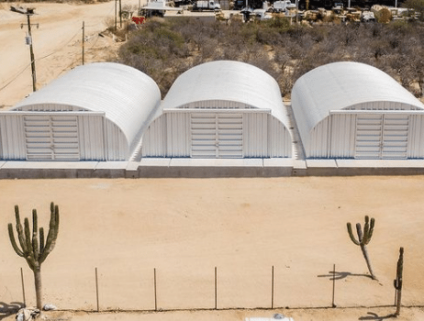How Cities Use Rock Salt To Keep Roads Safe After A Snowstorm

Preparation is key when it comes to keeping roads safe to drive on after winter snow storms. Cities across the Salt Belt (the northeast and midwest) rely on rock salt to effectively manage winter road conditions, keeping their citizens safe able to travel.
According to the EPA, approximately 11 tons of salt are used for every mile of road treated in a single winter season. Not only is anticipating how much salt your city will need important, but finding the right storage solution is equally important.
Why Rock Salt?
Rock salt is simply unrefined sodium chloride, the same as table salt. When spread on ice or snow it has a chemical reaction that lowers the freezing point of water from 32°F to about 15°F. Cities will use this to transform the more dangerous ice and snow on the roads to the less dangerous water.
Logistically, salt is inexpensive and, managed correctly, not harmful to the environment. Salt Belt cities rely on rock salt and plowing to keep their roads free of ice and snow so they’re safer for everyone.
How Cities Store & Use Rock Salt
1. Pre-winter Road Safety Planning
Being prepared is extremely important when gearing up for the winter months. During your preparation period, cities consider a number of factors when planning for winter road conditions:
Weather Forecasting: By looking at previous data and utilizing advanced weather forecasts, departments of transportation have a good idea of the severity of the upcoming weather likely to hit the region. While not always perfectly accurate, forecasting is an important part of winter planning.
Road Types: Traffic patterns and the types of streets (e.g., highways, local streets), that need to be cleared need to be considered for planning on deploying road maintenance crews during and after a storm.
Surface Area: Calculating the total amount of road surface area and comparing that against the budget to help determine the best way to allocate rock salt or snow plows in a given season.
2. Purchasing & Stockpiling
Before the first snowflake falls, most cities already have their stockpiles and trucks ready to go after summer and fall months of meticulous planning.
Stocking-up: The University of Vermont estimates that the Salt Belt uses about 20 million metric tons of rock salt every year on the roads, making it a major expense for cities and counties effort to keep the roads drivable.
Storing Rock Salt: To prevent salt from becoming wet and reducing its effectiveness, indoor road salt storage is now the standard. Specific EPA building requirements must be maintained to both protect the rock salt from the environment and the environment from the rock salt. SteelMaster’s bulk salt storage buildings offer an ideal solution for this purpose:
- Stem walls: Steel arches connect to the top of stem walls that prevent seepage into groundwater or surrounding soil.
- Easy Assemble: Buildings can be constructed by laborers or employees without specific construction knowledge or expertise.
- Clearspan Construction: The clear span arch design offers 100% usable interior space, accommodating large volumes of salt without internal supports.
- Weather Resistance: Our steel buildings are built to withstand severe weather conditions, including heavy snow loads, keeping stored salt dry and usable.
3. Clearing Roads After A Snow Storm
Every city, county or department of transportation has its challenges and methods for keeping the roads safe after a snowstorm. Depending on budgets, priorities and logistics, they all plan accordingly. Regardless of specifics, a combination of tactics are typically used to reduce the risk of drivers encountering dangerous, icy roads:
- Pre-treatment: In anticipation of snowstorms, some cities pre-treat roads with brine or other solutions, hindering snow on the roads before a storm hits.
- Snow Plowing: Done quickly enough, usually on main thoroughfares, plowing the snow off the road as soon as possible stops ice from forming all together.
- Salt and De-icing Treatments: Road crews spread salt or other de-icing materials to melt snow and ice.
Categories
Tags










